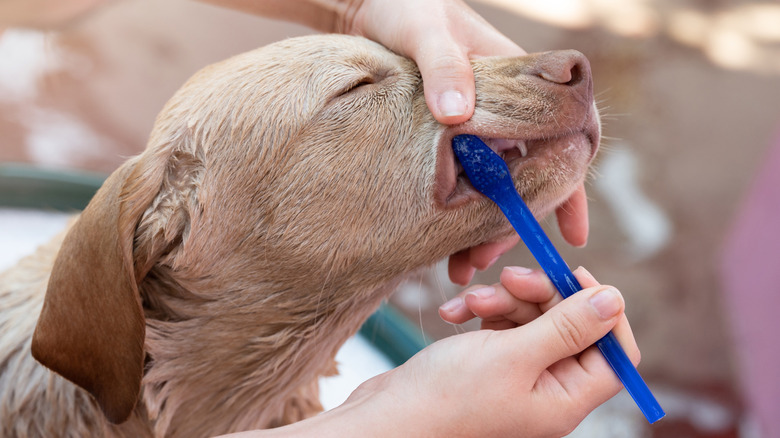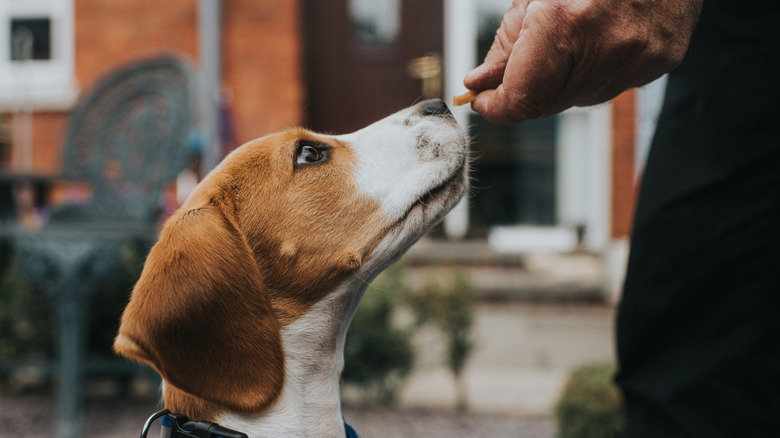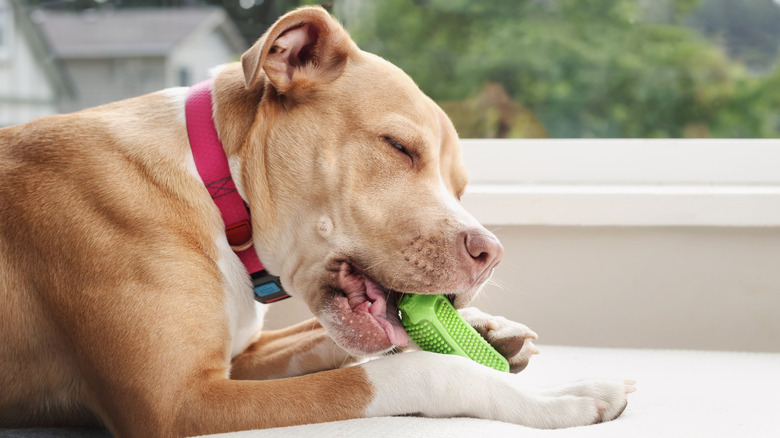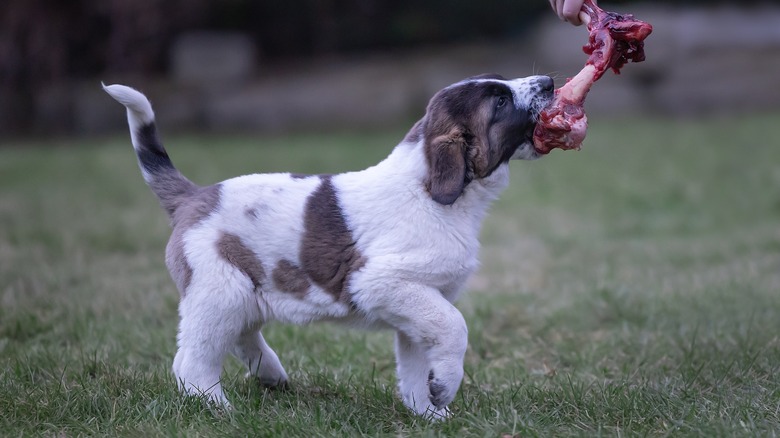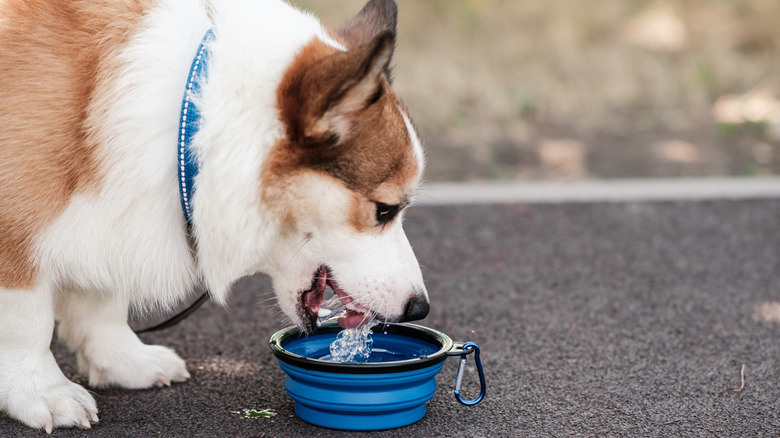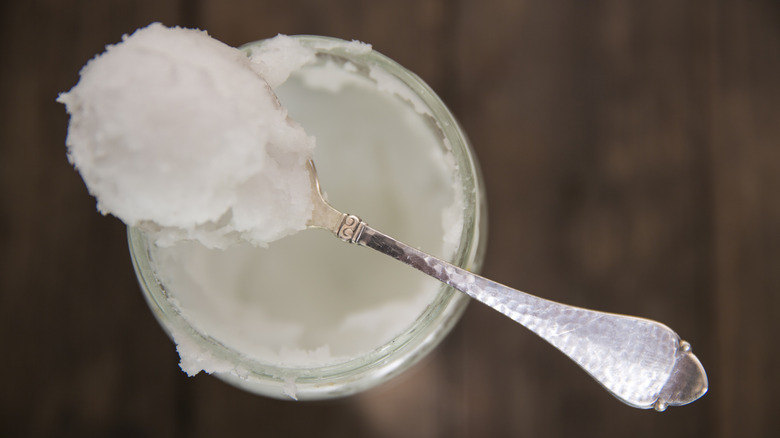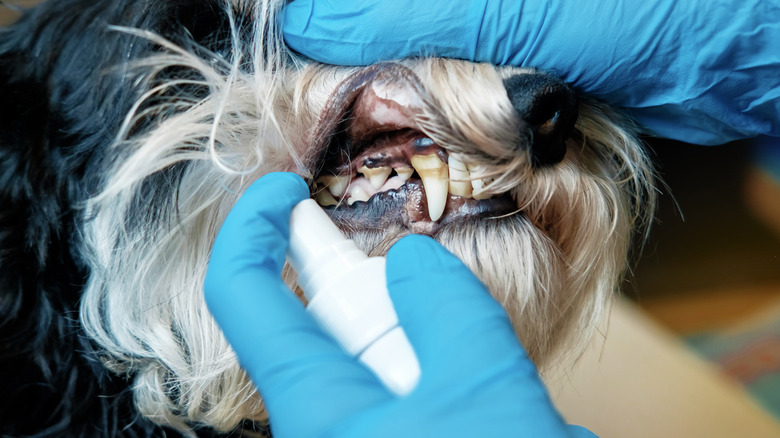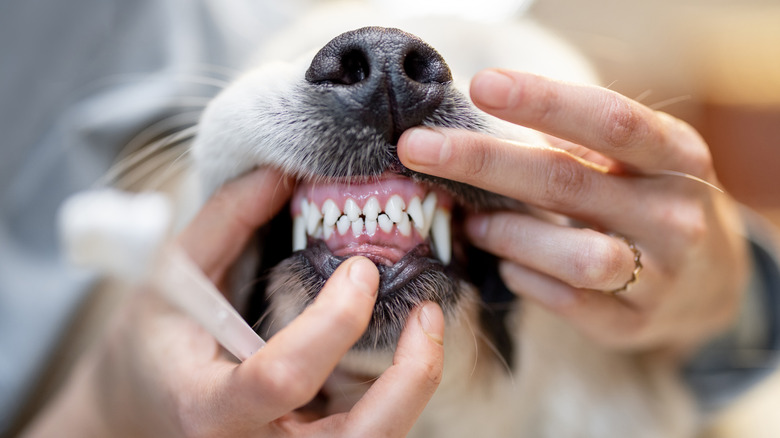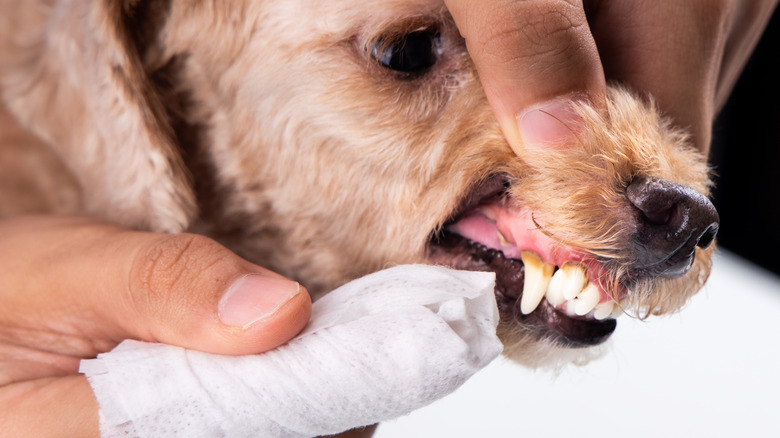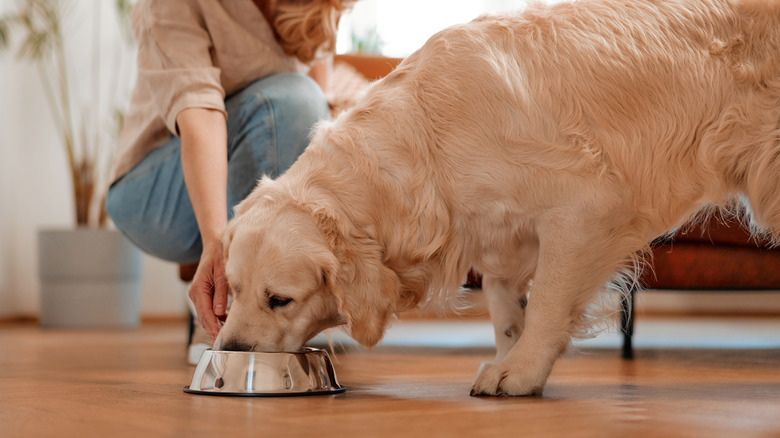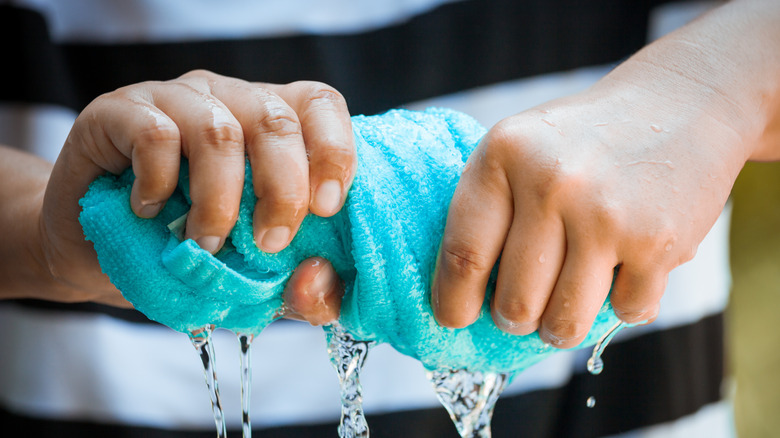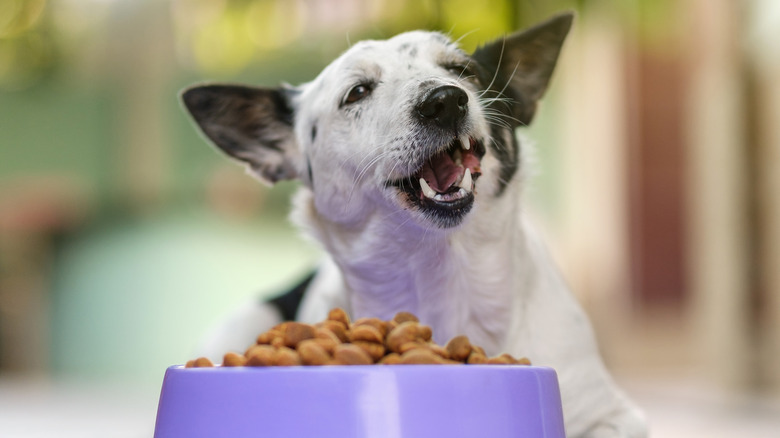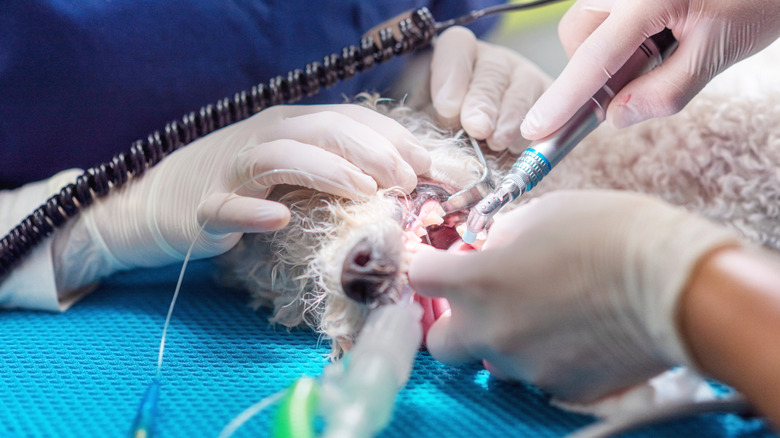The Best Ways To Clean Your Dog's Teeth (Without A Toothbrush)
We may receive a commission on purchases made from links.
Brushing your dog's teeth isn't the easiest task in the world, especially if they weren't introduced to toothbrushing at an early age. Impatience, a prior negative experience, the sensation, sore gums, the taste, and anxiety are all reasons why dogs may avoid their toothbrush at all costs. Thankfully, there are ways to clean your dog's teeth without a toothbrush, such as giving them dental chews, chew toys, dental water additives, crunchy fruit and vegetables, dental diets, dental wipes, and more.
As much as these mouth-cleaning options help remove some plaque and tartar, the truth is that nothing compares to brushing your dog's teeth with a toothbrush and dog-friendly toothpaste. Some pet parents don't think it's necessary to brush their dog's teeth because canines lived in the wild for thousands of years without human intervention, but that doesn't mean their oral health was in a good place. In fact, signs of gum disease rear their heads in many dogs by the age of 3, but because dogs hide pain well, owners think they're healthy. Frequent toothbrushing, taking your dog to their annual vet checkups, and dental cleanings will ensure that you won't have to take care of a dog with gum disease later in life.
Brushing your dog's teeth every day is ideal. However, people live busy lives, and toothbrushing can be extremely upsetting for some dogs. If you can't do it more often, aim to brush your dog's teeth at least three times a week while incorporating options from our list of ways to clean your dog's teeth without a toothbrush to augment their dental care.
Dental chews and treats
It's no secret that dogs love treats, so giving them dental chews or treats is an easy way to clean their teeth and freshen their breath. Dental treats and chews work by raking along your dog's teeth during the chewing process, but it's important to note that not all treats are effective or safe for dogs. To ensure that the treat or chew is getting the job done and isn't just a tasty snack, look for products approved by the Veterinary Oral Health Council (VOHC). The VOHC is made up of veterinary dentists and dental scientists who review products and give the council's Seal of Acceptance to ones that meet their standards of reducing plaque and tartar in pets.
To save money, some people give their dogs ice to chew on as a crunchy, teeth-cleaning treat. However, there's a hidden risk of giving your dog ice. It can break weak teeth when chewed because of its hardness. Dental chews and treats are much more effective at cleaning your dog's teeth than ice, but if you're still looking to give them a cold treat on a hot day, make them a slushie by putting your ice cubes into a blender for a few seconds. For a tasty dog chew made from healthy ingredients and approved by the VOHC, check out the Virbac C.E.T. VEGGIEDENT Zen Tartar Control Chews.
Chew toys
Dogs, especially puppies, can get mouthy when excited or eager to play with you. Puppies who are teething like to chew to ease their irritated gums and to discover new textures and flavors. Chew toys are an excellent tool when teaching your dog not to playfully bite you, as you can redirect their attention from your body to their toy. They're also entertaining and can keep your pup busy instead of getting up to mischief. Some types of chew toys, specifically those with the VOHC Seal of Acceptance, are also great at scraping plaque off of teeth.
Although dogs will happily chew on sticks and stones, getting them a chew toy is a safer and more effective teeth-cleaning option. Items like rocks can break their teeth, and sticks can become lodged in the roof of their mouth or splinter and cut their throat. Appropriate toys should slightly indent when you push your nail into them and be made of safe, durable materials. The HEYKEY Dog Toy for Aggressive Chewers is one of many excellent chew toy options on the market, and dog parents are going wild for this teeth-cleaning chew toy because it's made from durable, non-toxic materials and squeaks and releases a milk scent when bitten, which keeps dogs entertained for longer. If you already have an effective teeth-cleaning chew toy that your dog loves, you can smear some of their toothpaste into its fibers or grooves to freshen their breath.
Dog bones
William Draper, a veterinarian and content editor for WebMD, explained in an interview for the health outlet that before humans domesticated dogs, their teeth were cleaned without the use of a toothbrush and instead benefited from chewing on bones as they "strengthened their teeth, they stimulated their gums," and "[they] wore off some of the plaque and tartar." Although a bit controversial, Kate Jackson, a certified dog trainer, added, "Raw beef bones that you buy from your grocery store or the butchery" can clean your dog's teeth in the same way.
Although chewing on the bones from raw carcasses cleaned the teeth of undomesticated dogs to some degree, teeth cleaning has come a long way, much like with humans. Today, with the use of toothbrushes, toothpaste, and dental cleanings, gum disease can be avoided. If you decide to offer your dog raw beef bones, do so under supervision. Never give your dog chicken bones or soft, cooked bones because they can splinter when bitten into, which can cause internal damage or a blockage.
Dental water additives
Dental water additives approved by the VOHC are the safest and most effective options for pets, but there are a few homemade mouthwashes for dogs that can also work wonders. They don't just freshen their breath; they also clean their teeth. The best thing about dental water additives is that they're a stress-free option for dogs who hate having their teeth brushed every day, allowing you to brush your dog's teeth every other day and use this option in between.
According to a 2023 study published in Frontiers in Veterinary Science, a group of dogs given water additives had significantly less plaque and calculus on their teeth 30 days after they went in for dental scaling and polishing than a group of dogs that didn't receive the water additives. Water additives mixed with your dog's water work by controlling the growth of bacteria in your dog's water and mouth, which reduces odor and plaque buildup. They often contain natural antioxidants and prebiotics — one example being the Virbac C.E.T. Aquadent Dental Solution.
Coconut oil
According to 2016 research published in the Ghana Medical Journal, "[c]oconut oil is the highest natural source of lauric acid," which, in turn, means that coconut oil has antibacterial properties. According to another 2016 study, this one published in the Journal of International Society of Preventive and Community Dentistry, oil swishing with coconut oil over a period of 30 days proved to be as effective as swishing with the antiseptic agent chlorhexidine, as both reduced Streptococcus mutans (a tooth-decaying bacteria) in the participants' mouths. Although the bacteria in a dog's mouth differs from a human's, and there aren't studies about coconut oil specifically reducing plaque in dogs, some vets recommend it, including Dr. Andrew Jones, DVM, who specializes in natural health solutions for dogs and cats.
Before applying coconut oil to your dog's teeth and gums, consult your vet because they know how healthy your dog is physically and orally. They may recommend a specific product that's better suited for your dog's needs or recommend you give coconut oil a try. Coconut oil is safe for most dogs and can even be ingested in small amounts. If your dog responds well to coconut oil, you can also use it on their coats as a homemade dog conditioner. Coconut oil is a cost-effective product that most people have in their homes, so if your vet gives you the all clear, you'll be on your way to a happier, healthier mouth without breaking the bank.
Apples and carrots
Apples and carrots are crunchy and nutritious snacks for your dog, and they can also clean their teeth as they munch through them. Although both options are low in calories, dogs get most of their daily caloric intake from their dog food, so you should give extra snacks in moderation. Along with apples and carrots, any other dog-friendly crunchy fruit or vegetable, such as pumpkin, will be effective at removing plaque from teeth. But remember: The objective of eating crunchy foods is to contribute to improving your dog's oral health, not to replace regular toothbrushing.
Carrots are one of the vegetables that are safe for dogs, but to prevent choking, cut them up into smaller pieces. These orange veggies are low in calories, which makes them a great snack for dogs that need to lose weight. They're also packed with vitamins and minerals, and are high in fiber. Apples are also a great snack option for dogs that are sweet, full of antioxidants, and aid in digestion. However, you must be cut them into smaller pieces and remove their cores to make them safer for your dog to eat. You must also remove the pips (seeds), as they're toxic to dogs.
Dental sprays
If you're looking for ways to disinfect a dog's mouth and clean their teeth in a stress-free way, dental sprays are a good option to consider, as they're quick and easy to use. You don't have to spray each tooth; rather, you spray right into your dog's mouth. As the solution mixes with your dog's saliva, it will work its way throughout your dog's mouth and onto their teeth to remove and prevent plaque. Each product has its own instructions, so be sure to read through them so you know how many sprays your dog will need based on their size and dental condition. Some people claim that dental sprays eradicate the need for a toothbrush, but this is untrue. Instead, veterinarian Lindsey Schneider told the Cornell University Hospital for Animals that dental sprays are most effective when used "immediately before or after" toothbrushing, but you should always read the "manufacturer instructions for their recommendation."
The Oxyfresh Advanced Pet Dental Spray is a good option for picky dogs because it's tasteless. It's also 100% non-toxic to both cats and dogs. You can even opt between spraying it directly into your dog's mouth to freshen up their breath or into their water bowl if they don't enjoy the spray sensation.
Dental gels
A 2002 study published in the Journal of Veterinary Dentistry saw veterinarian Philippe Hennet study the oral health of 11 beagle dogs. After the dogs' teeth were professionally cleaned, a dental gel containing chlorhexidine was applied to their teeth twice a day for seven days. The results showed that these dogs had less plaque than the control group. The study concluded that if the dogs' owners continued to apply the dental gel used in the study long-term, "the severity of gingivitis and associated periodontal disease" would be reduced.
That said, dental gels still aren't as effective as toothbrushing, but they can prevent severe cases of gingivitis. Therefore, dental gels are one of the best products to use daily if your dog refuses to let you brush their teeth no matter how hard you try. Dental gels are a little more difficult to use than dental sprays because you have to rub the gel directly onto your dog's gum line, making sure to move over every tooth at the top and bottom of their mouth. You can apply it with your finger, or you can apply it to a toothbrush or finger brush if your dog is comfortable with it.
Dental wipes
Dental wipes are a good option to use if your dog refuses a toothbrush, as they remove some of the plaque from their teeth. However, without the bristles of a toothbrush, you won't be able to reach the tight spaces between their teeth. Dental wipes are convenient because they come ready to use and are easy to travel with. They're soft and more accepted by dogs that don't like bristles and rough textures, though most do have bumps or grooves to help remove plaque. They also contain ingredients that will leave your dog's breath smelling fresher.
You should move the dental wipe in a circular motion over your dog's teeth and gum line, and use as many as necessary to clean both sides of each tooth. You must not use human wipes or pet wipes intended for external use to clean your dog's teeth, as they could contain ingredients that are harmful if ingested. There are different sizes and flavors of dental wipes so that you can get the type best suited to your dog. For instance, the Vetnique Dentabliss Dental Wipes are peppermint flavored for a fresh smell, and each wipe has a side with little bumps on it to scrape off plaque, along with a quilted side that polishes the teeth afterward.
Dental powders
Similar to dental water additives, dental powders are a stress-free way to clean your dog's teeth because you can pour a scoop over their food without them even knowing. Some dental powders are flavored and may even improve the taste of your dog's food. Dr. Jan Bellows, a board-certified veterinary dentist, backs the PetLab Co. ProBright Advanced Dental Powder because it's made from high-quality ingredients and significantly reduces bad breath within 28 days (via the American Kennel Club). Just what's in it? Well, it contains probiotics, brown algae, green tea, rosemary leaf extract, and sodium hexametaphosphate, which fight bacteria, reduce bad breath, and prevent tartar buildup.
There are many other dental powders that are also effective at reducing plaque and improving the smell of your dog's breath. If you're not sure which products to trust, look through the VOHC list of accepted products.
Using a cloth
Just about every home has a cloth or two lying around, so if you can't get your hands on any of the other products on our list or if you're on a tight budget, grab your handy-dandy cloth. A wet cloth works similarly to dental wipes; however, a cloth isn't as convenient as a dental wipe because it doesn't come pre-moistened, and you'll need to clean it after every use instead of discarding it (which actually makes this option pretty sustainable). Moreover, it doesn't contain any ingredients that are effective at freshening your dog's breath.
However, for some dogs, a wet cloth might be all they will tolerate near their mouth, or it could be your first step in the process of warming your dog up to using a toothbrush. Start by wetting the cloth to soften it. You can use water or chicken or beef broth to make it taste nice and make the process more appealing for your dog. A wet cloth is less irritating to your dog's gums and loosens the plaque on their teeth. You can then wrap it around your finger and rub each tooth in a circular motion to remove the plaque. If your dog is comfortable with the cloth, you can try adding dog-friendly toothpaste or dental gel to it to freshen their breath and reduce bacteria in their mouth. Once your dog is comfortable with you regularly cleaning their teeth with a cloth, you can try to introduce a toothbrush.
Dental diets
We're here to bust the myth that dry food can clean your pet's teeth. There is little evidence to support the myth that dry food is superior to canned food when removing plaque from your dog's teeth. However, dental diets containing dry kibble shouldn't be compared to regular kibble, as they've been proven to be much more effective. A 2007 study published in the Journal of Veterinary Dentistry — this one also written by veterinarian Philippe Hennet — found that when the diameter of kibble is increased by 50%, it can reduce plaque by 42%. It's even more effective at removing plaque when coated with sodium tripolyphosphate, which can sound scary but really isn't — and it's not too expensive. The Eisen-Golden Laboratories Sodium Tripolyphosphate Food Grade Powder is just $7.99 for a 3-oz. bottle.
Overall, if your dog won't let you brush their teeth daily, chat with your vet about starting your dog on a special dental diet. When looking into different options, make sure the dental diet is VOHC-accepted, as many diets claim to be effective but aren't.
Regular dental cleanings
Even if you brush your dog's teeth every day and use teeth-cleaning products, you'll miss areas, and tartar can accumulate. You may think your dog's teeth look clean, but a vet knows what to look out for, which is why it's so important to take them to their annual checkups. Here, your vet will examine your dog's body, take blood and urine samples, ask you questions about their diet, examine their teeth and gums, and more. Generally, dogs need a dental cleaning every year, though their size, breed, and how often you brush their teeth may impact how frequently you need to go in.
In the case of dental cleaning, your dog will be put under a general anesthetic, and your vet will scale and polish your dog's teeth and put a sealer on them. It must be done under anesthesia to avoid injury to your dog and vet, as no dog has the patience to sit still with their mouth open during a dental procedure. It can also be very stressful for them. In severe cases of gum disease, your vet may also need to remove damaged teeth. However, with regular toothbrushing, the use of teeth-cleaning products, and regular dental cleanings, your dog should never experience severe gum disease.
